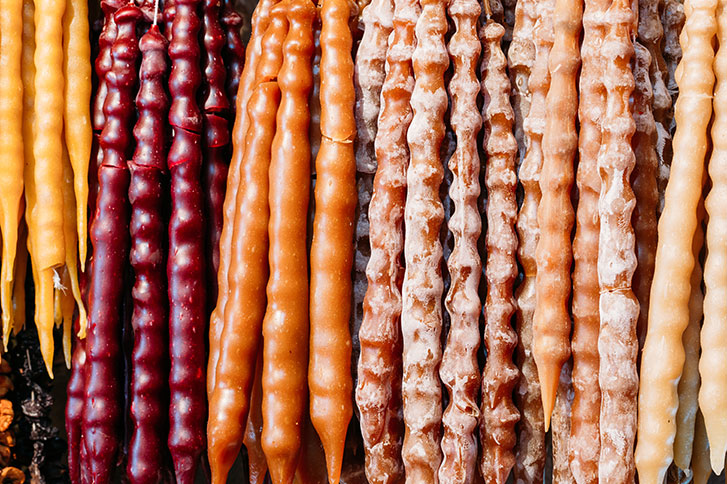Russia

Russia, in terms of sheer area, is the largest country in the world — it stretches across 11 time zones and borders 14 countries (many of which were formerly part of the Soviet Union). Each year on June 12, its citizens observe Russia Day, a celebration that in scope and feel is similar to American Independence Day, Canada Day, King Day in the Netherlands, and so forth. Russia Day is characterized by fireworks, parades, flag-waving and marching bands, entertainment and special events, and the bestowing of State Awards on prominent humanitarians, scientists, literary figures, and others. What foods might be served at such a celebration, and what do Russians enjoy on an everyday basis?
If it’s true that, as Winston Churchill once said, “Russia is a riddle, wrapped in a mystery, inside an enigma,” conversely, its cuisine could be considered straightforward because, as is true of so many other regions around the world, what is grown and consumed is dictated largely by climate; in this case, for the most part, a cold climate. Meals tend to be heavier and heartier, incorporating crops that tend to do well under these circumstances, including root vegetables (beets, turnips, onions, potatoes), grains (rye, wheat, barley, buckwheat), and cabbage. Influences from its neighboring countries are also present, of course, as well as those of some long-ago chefs from Italy and France who were summoned by Tsars throughout history, under whose employ they came up with some innovative dishes.
Many of Russia’s culinary characteristics are reminiscent, not surprisingly, of those popular in Ukraine (such as the ubiquitous use of sour cream “as Americans use ketchup,” according to the travel section of USA Today), but there are some that are native to Russia. Such as…
- Borscht or Borshch – The ever-popular beet soup, which is a sweet-and-sour main course that incorporates the aforementioned root vegetables (especially, of course, beets which give it its bright red color), beef broth, and…yes…a little sour cream. This soup, which is served either hot or cold, also comes in beet-less white and green varieties. There is even an orange-tinged borscht made with tomatoes rather than beets. Lots of variations, to suit every taste (for instance, Epicurious adds bacon and garlic). A non-borscht alternative is Shchi, a traditional Russian cabbage soup, the components of which sometimes include sauerkraut.
- Salat Olivier (Russian Salad) – this dish was created by a visiting French chef for the ill-fated Tsar Nicholas II (yes, the unfortunate identical cousin of Britain’s King George V who was assassinated with his family in 1918), and isn’t really a salad as we know it today. It is composed of potatoes, hard-boiled eggs, bologna, pickles, carrots, onions, peas, a few large lettuce leaves as a base, and mayonnaise. Lots and lots of mayonnaise, both mixed in with everything and also slathered on top. If you like mayonnaise, this is the salad for you.
- Bliny/Blintzes (Russian Pancakes) – Did you know that Russia has its own version of Fat Tuesday/Mardi Gras just before Lent? Well, it does, and it’s the perfect time to indulge in these very thin Russian pancakes known as bliny (they are perhaps more familiar to us as blintzes). These are closer to crêpes than traditional pancakes as we know them in America, and are generally filled with fruit, butter, sour cream, or, if you prefer savory blintzes, smoked fish or caviar. Speaking of caviar...
- Caviar – The grandson of Genghis Khan, whom as you may recall brought steak tartare to Russia, was also evidently responsible for introducing caviar to the country as well. Russian caviar, made from sturgeon roe, is a rare delicacy, and Beluga caviar, made from the rare and endangered Beluga sturgeon, is considered the extremely expensive gold standard. It has traditionally been an indulgence of the rich, goes well with champagne and crackers, and is sometimes used in recipes.
- Beef Stroganoff – This quintessentially Russian dish was created not by a Russian, but by (of course) a Frenchman. In 1891, chef Charles Briere entered and won a cooking contest in St. Petersburg with this recipe, and true to tradition, he may have named it after the ultra-wealthy family for whom he worked at the time: the Stroganovs. It incorporates cubed steak, egg noodles, sliced mushrooms, flour, and spices, and is easy and quick to prepare. A win-win!
-
Desserts – The Russians are very big on dessert, and they have many — popular ones include gingerbread (the most famous coming from Tula, a town near Moscow); Birds’ Milk Cake, which incorporates marshmallow and chocolate; Pastila, utilizing apples and honey and similar in taste and texture to Turkish Delight; Vatrushka, a filled round bun; and Churchkhela, which is essentially nuts on a string soaked in flour-thickened grape juice, which forms its chewy coating. (It’s much prettier than it sounds.)

Churchkhela - Libations – What do Russians drink with all of this? Vodka, of course! Or a Baltika beer, from the country’s largest brewery — one of the most prominent brands in all of Europe.
So put on some balalaika music for atmosphere, dish up some borscht and Beef Stroganoff, and quaff some vodka or a nice Baltika. In Chicago, you can also try the sumptuous afternoon tea — including blintzes! — at Russian Tea Time. Or, head up to Skokie and sample the Russian fare at Zhivago (wonder where that name came from?).
За здоровье! (To your health!)





